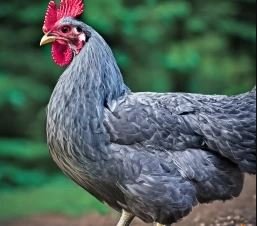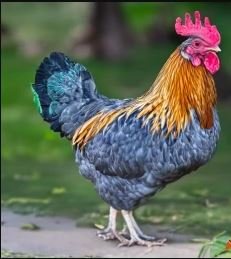Discover everything about Blue Marans chicken, their origin, appearance, Egg production, boosting egg production, benefits, mortality ways, and many more.
Blue Marans Chicken Origin and History
The Blue Marans chicken traces its roots back to the port town of Marans in France, where it was developed in the early 20th century. Initially bred for their exceptional egg-laying abilities, Marans chickens were prized for their dark brown eggs, which were highly sought after in local markets. Over time, breeders began experimenting with different color variations, leading to the emergence of the Blue Marans variety.
Blue Maran Chickens Appearance
Blue Marans chickens are renowned for their striking appearance, characterized by slate-blue feathers with hints of copper or black. Their plumage is glossy and lustrous, giving them an elegant yet rustic charm.
Blue Marans Chickens Colors
While the classic Blue Maran chicken exhibits shades of blue in its plumage, there are also other color varieties within the breed. These include Black Copper Marans, Wheaten Marans, and Cuckoo Marans, each with its own distinct color pattern and markings.
Blue Maran Chicken Shape
The Blue Maran chicken typically has a compact and robust build, characterized by a broad chest, well-rounded body, and strong legs.
Blue Maran Chicken Size and Weight
Blue Marans chickens generally have a medium-sized build, with roosters averaging around 18-20 inches in length and hens slightly smaller, measuring around 16-18 inches in length.
Blue Marans chickens generally weigh between 6 to 8 pounds, with roosters being slightly larger than hens.

Blue Marans Chicken Rooster vs. Blue Marans Hen
Size and Appearance:
Blue Marans roosters are generally larger and more muscular compared to hens.
Roosters typically have larger and more prominent combs and wattles.
Hens are usually smaller in size with a more streamlined appearance.
Plumage:
Both Blue Marans roosters and hens exhibit the characteristic blue plumage with copper or black accents.
Roosters may have more vibrant or iridescent plumage compared to hens.
Behavior:
Blue Marans roosters are known for their protective instincts and may exhibit more assertive behavior, especially towards perceived threats.
Roosters often crow loudly to assert their dominance and communicate with the flock.
Hens are typically quieter and more docile, focusing on foraging and nesting activities.
Reproductive Role:
Roosters play a crucial role in the reproductive process by mating with hens to fertilize eggs.
Hens are responsible for laying eggs, which may be fertilized by roosters if breeding is desired.
Egg Production:
Blue Marans hens are prolific egg layers, known for their production of beautiful blue eggs.
Roosters do not lay eggs; their primary role is in mating and fertilization.
Interaction with Flock:
Roosters often take on the role of flock protector, keeping watch for predators and alerting the hens to potential dangers.
Hens form close bonds within the flock, engaging in social behaviors such as mutual grooming and dust bathing.
Blue Marans Chicken Eggs
One of the most remarkable features of Blue Marans chickens is their egg production. Not only do they lay a respectable number of eggs, but the eggs themselves are prized for their unique color and flavor.
The starting age of Egg Laying and Egg Production Span
Blue Marans chickens usually begin laying eggs when they’re about 5 to 6 months old. once they start laying, they can keep producing eggs for a few years, usually until they’re around 3 or 4 years old.
Blue Marans Chicken Egg Color
The hallmark of Blue Marans eggs is their beautiful blue hue, which ranges from pale sky blue to deep teal. This distinctive color is due to the presence of a pigment called oocyanin, which is deposited on the eggshell during the laying process.
Blue Marans Chicken Egg Production per Year
A healthy Blue Marans hen typically lays between 150 to 200 eggs per year, with peak production during the spring and summer months.
10 egg-layers champion chickens.

Factors Affecting Blue Marans Chicken Egg Production
Nutrition
To ensure your Blue Marans chickens are laying their best, make sure they’re getting a nutritious diet packed with protein, vitamins, and minerals. opt for a high-quality poultry feed tailored for laying hens.
Click, For complete and season specific diet plan of chickens.
Lighting
During the darker winter months, your Blue Marans chickens might need a little extra help to keep laying those delicious eggs. Try adding some extra lighting in their coop to mimic the longer days of spring and summer. About 14 to 16 hours of light per day should do the trick!
Stress Levels
Keep your Blue Marans hens happy and laying by providing a stress-free environment. Ensure they have ample space, protect them from predators, and maintain a stable living environment for optimal egg production.
Breeding Stock
To identify top-quality breeding stock for your Blue Marans flock, look for signs such as consistent egg production, sturdy build, and vibrant plumage. Select birds with a history of excellent health and temperament, as these traits often indicate strong genetics and suitability for breeding. By choosing birds with these characteristics, you’ll be well on your way to establishing successful years to come.
Blue Marans Chicken Benefits
For Enthusiasts
Blue Marans chickens lay stunning blue eggs that can fetch a premium price, offering potential financial benefits for egg sales.
Their attractive appearance and dual-purpose capabilities make them sought after by breeders and buyers alike, potentially increasing their value.
By raising Blue Marans chickens, enthusiasts can potentially generate income through egg sales, breeding stock, or even meat production, providing a valuable source of revenue.
For Small-Scale Farmers
Egg Sales: Specialty blue eggs can fetch premium prices, potentially increasing income from egg sales.
Breeding Stock: Selling quality breeding stock to enthusiasts can provide additional revenue.
Meat Production: Blue Marans chickens have dual-purpose capabilities, allowing for potential income from meat sales.
Pest Control: Their natural foraging behavior helps control pests, leading to healthier crops and potentially higher yields, further contributing to financial gains.
Blue Marans Chicken Mortality Ways in Captivity
Predation Risk: Secure coops and runs to protect against foxes, raccoons, and birds of prey.
Predators can easily target unprotected chickens, leading to fatal attacks.
Disease Prevention: Maintain hygiene and vaccinations to prevent illnesses.
Diseases like Marek’s disease or avian influenza can quickly spread and cause mortality.
Accidents: Keep the environment safe to avoid drowning, suffocation, or injury.
Mishaps like getting trapped or falling can result in fatal outcomes.
Weather-related Stress: Provide shelter from extreme weather conditions.
Exposure to harsh weather can cause stress, leading to health complications.
Internal Health Issues: Monitor for signs of egg binding or respiratory problems.
Internal issues, if left untreated, can result in mortality.

Blue Maran Chicken Price
Initial Investment:
If you’re thinking about adding Blue Marans chickens to your flock, be prepared for an initial investment. Quality breeding stock or hatching eggs can range in price from $5 to $24 per chick or egg, depending on factors like lineage and rarity of color variety.
Ongoing Expenses:
It’s essential to budget for ongoing expenses to ensure the health and well-being of your Blue Marans flock. These expenses may include housing, feed, healthcare, and other supplies.
Total Cost:
While the initial investment and ongoing expenses can add up, the joy of owning these beautiful and productive birds can be priceless. Be sure to budget accordingly to provide the best care for your Blue Marans chickens.
Conclusion:
In wrapping up, Blue Marans chickens offer a perfect blend of beauty, productivity, and practicality for any poultry enthusiast. Their stunning blue eggs and dual-purpose nature make them a valuable addition to any flock. While there are costs involved, the joy and satisfaction of raising these remarkable birds make it all worthwhile. With proper care, Blue Marans chickens can thrive and bring endless delight to both beginner and experienced poultry keepers alike. So, whether you’re just starting out or looking to expand your flock, consider adding Blue Marans chickens—they’re sure to bring charm and utility to your farm.
How long do Marans lay eggs?
Blue Marans chickens can continue to lay eggs well into their third or fourth year of life, with peak production typically occurring during the first two years.
Are Marans good for beginners?
Yes, Marans chickens can be suitable for beginners, especially those interested in raising dual-purpose breeds for both eggs and meat.
Why are Marans so expensive?
Marans chickens, particularly those with desirable coloration and egg quality, can command higher prices due to their popularity among poultry enthusiasts and breeders.
Are Blue Marans rare?
While Blue Marans chickens are not as common as some other poultry breeds, they are not considered rare. However, certain color varieties, such as Black Copper Marans, may be more sought after by enthusiasts.
What is the color of Blue Maran chicken?
Blue Marans chickens have slate-blue feathers with hints of copper or black, giving them a distinctive and attractive appearance.
How many eggs does a Blue Marans chicken lay per year?
Blue Marans chickens can lay anywhere from 150 to 200 eggs per year, depending on various factors such as diet, genetics, and environmental conditions.


1 thought on “All about French Blue Marans Chicken: A productive pet.”